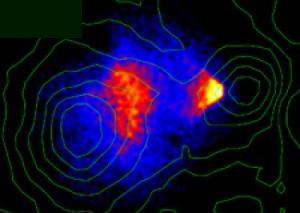|
Dark Matter Of The Universe Has A Long Lifetime
ScienceDaily (Oct. 4, 2007) — New research from the Niels Bohr Institute presents new information that adds another piece of knowledge to the jigsaw puzzle of the dark mystery of the universe -- dark matter. The universe consists not just of visible celestial bodies, stars, planets and galaxies. It also has a mystical fellow player -- dark matter. The astronomers can measure that the dark matter exists in big quantities but no one knows what it is, nobody has seen it. It does not emit light and it does not reflect light. It is invisible. It is a mystery and the researchers have many theories. The dark matter has caused the researchers headaches for decades since it was detected in the 1970s, and there is intense research into the phenomena. It is invisible but it has got mass, and thus it has got gravitation that can be measured. By analysing the galaxies it is possible to weigh them, and it turns out that by far the greatest matter of the collective mass of the galaxy is dark matter. Just like stars get together in galaxies, the galaxies get together in clusters of galaxies of up to several thousand galaxies. The astrophysicist Signe Riemer-Sørensen, PhD student at the Niels Bohr Institute, has analysed two clusters of galaxies that collide. Colliding clusters of galaxies When the two clusters of galaxies meet neither the galaxies nor the dark matter collide. However, about 12 per cent of the mass of the cluster of galaxies consists of huge clouds of gas and dust and these clouds collide. The gas clouds are hot and emit x-ray that can be observed, and it is possible to see how the clouds are actually pushed out of the two clusters of galaxies at the collision. When the clouds of gas collide they become even hotter and emit more x-ray so that a whole chock front of warn gas is generated. Observations indicate that the dark matter can be a new and still undetected type of particle. Among the suggestions for the dark matter, are particles that when they decay they emit x-ray. One is the so called axions that are particles which is explained in theories with extra dimensions. So to be able to look for x-ray from dark matter the researchers are looking in places where there is a big concentration of dark matter, but no gas. Such places are found in the two colliding clusters of galaxies where the gas clouds have been pushed out at the collision. Signe Riemer-Sørensen has analysed the one of the two clusters of galaxies that are in the process of colliding. The analyses show that it is a very heavy cluster with many galaxies, and measurement of the gravitation show that there is a very big amount of dark matter, up to 85 per cent of the collective mass. However, no x-ray of any consequence was measured. When the dark matter does not emit significant x-ray it is possible to calculate an upper limit to how quickly the particles decay and thus calculate their lifetime. The result is that if axions are to be the dark matter they must have a life span that is longer that 3.000.000 billion years. In that case there is not very much dark matter that has decayed yet if it was formed 13.7 billion years ago. The conclusion is that dark matter has a very, very long lifetime. The research has just been published in the scientific journal Physical Review Letters. Adapted from materials provided by University of Copenhagen, via EurekAlert!, a service of AAAS. Click here for previous dark energy article
|
